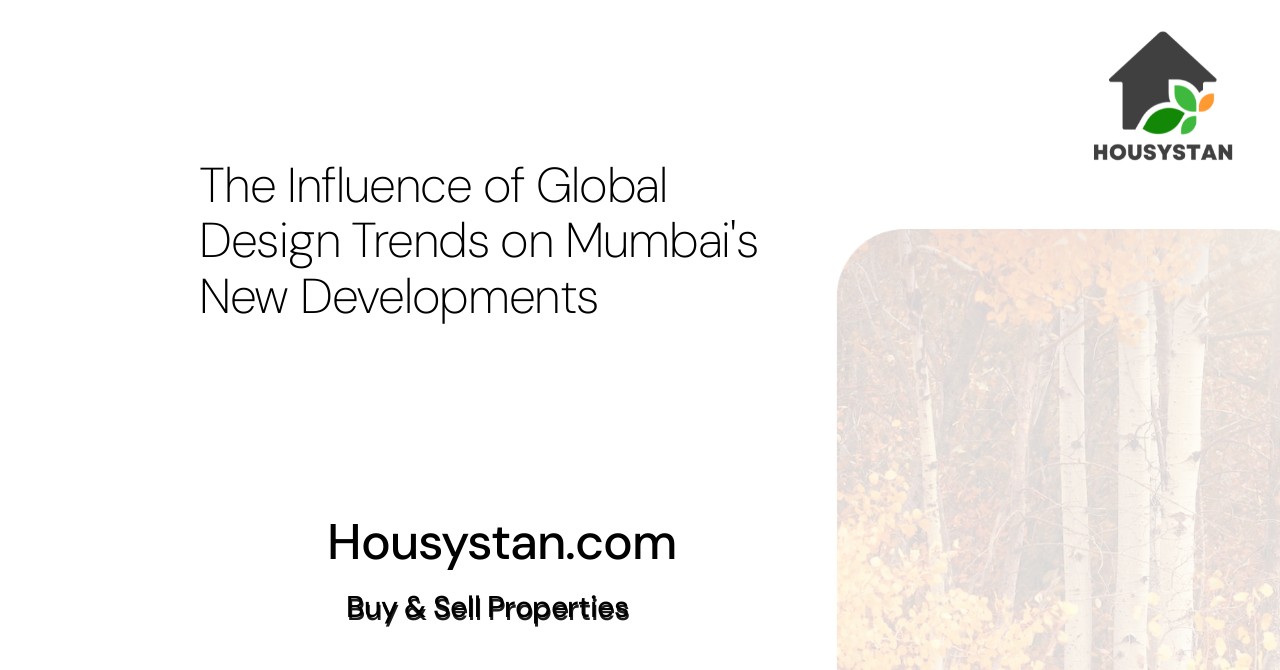The Influence of Global Design Trends on Mumbai's New Developments
Read latest blogs and articles from Housystan

The Information mentioned here was last updated on:
13/1/2026The Influence of Global Design Trends on Mumbai's New Developments
Mumbai, often referred to as the city that never sleeps, is a bustling metropolis that's constantly evolving. As one of India's major urban centers, Mumbai is not only a hub for commerce and culture but also a melting pot of architectural styles and design influences. In recent years, global design trends have played a significant role in shaping the city's new developments, influencing everything from residential buildings to commercial spaces. Let's explore how these trends are transforming the face of Mumbai, making it a vibrant and dynamic city on the cutting edge of modern design.
The Rise of Sustainable Architecture
- Verified Tenants/Buyers
- Unlimited Property Listing
- Zero subscription/charges fee
Sustainability has become a crucial part of architectural design worldwide, and Mumbai is no exception. With the increasing awareness of climate change and environmental challenges, architects and developers are incorporating eco-friendly practices and materials.
- Green Building Techniques: Mumbai has seen a surge in the use of energy-efficient construction techniques, such as green roofs and solar panels, which help reduce the city's carbon footprint.
- LEED Certification: Many new developments in Mumbai are seeking LEED (Leadership in Energy and Environmental Design) certification, ensuring that buildings meet high standards of energy efficiency and environmental sustainability.
- Recycled Materials: The use of recycled and locally-sourced materials has become popular, reducing waste and supporting local economies.
Embracing Minimalism and Functionality
Global design trends have increasingly favored minimalism, and Mumbai's architecture is reflecting this shift. The focus is on clean lines, open spaces, and practical design that prioritizes functionality.
- Open-Plan Living Spaces: In many new residential buildings, open-plan layouts are becoming common, promoting a sense of freedom and space in densely populated areas.
- Smart Home Technology: Integrating smart technology is not only about convenience but also efficiency. Homes equipped with automation systems for lighting, security, and climate control are gaining popularity.
- Neutral Palettes: A preference for neutral color schemes allows for versatility and personalization, making spaces feel modern yet timeless.
Influence of Global Architectural Styles
Mumbai's skyline is becoming a patchwork of diverse architectural styles borrowed from across the globe. This blend of aesthetics is reshaping the cityscape in innovative ways.
- Contemporary Scandinavian Influence: The simplicity and elegance of Scandinavian design have made their way into Mumbai's developments, characterized by natural materials and a focus on functionality.
- Bold Industrial Designs: Taking cues from New York and London, industrial designs featuring exposed brick, metal elements, and large windows are emerging, especially in commercial spaces.
- Neo-Futurism: Inspired by international icons like Zaha Hadid, neo-futuristic designs with sweeping curves and striking forms are becoming more prevalent.
Building for a Smart City
Mumbai's journey towards becoming a smart city is driving many of the latest developments. The integration of advanced technologies into infrastructure and services is aimed at improving the quality of life and urban efficiency.
- Integrated Transport Systems: Developments are increasingly prioritizing accessibility to public transport, reducing reliance on cars and encouraging the use of greener commuting options.
- Digital Infrastructure: The implementation of high-speed internet and connectivity across developments is essential for supporting a digitally-savvy population.
- Urban Planning Innovations: Concepts like mixed-use development—where residential, commercial, and recreational spaces coexist—are being incorporated to ensure efficient use of space.
Reinventing Public Spaces
Public spaces in Mumbai are being reimagined through the lens of innovation and inclusivity, reflecting global trends towards community-centric urban design.
- Revitalization of Waterfronts: Projects to redevelop Mumbai's coastlines are focusing on creating accessible, attractive public spaces that enhance the city's connection to the sea.
- Community Parks and Plazas: New developments emphasize greenery and communal areas where people can gather, socialize, and relax.
- Art Installations: Public art is becoming a staple in new projects, creating cultural landmarks and enhancing the aesthetic appeal of the urban environment.
The Role of Cultural Sensitivity
While global trends heavily influence new developments, there's a conscious effort to retain Mumbai's unique cultural identity. Balancing modernity with tradition is key.
- Traditional Elements in Modern Design: Integrating traditional motifs and materials into modern structures ensures a connection to the city's rich heritage.
- Community Consultation: Developers are increasingly engaging with local communities to ensure new developments meet their needs and preferences.
- Preservation of Historic Structures: Efforts to preserve and renovate historic buildings while integrating them into modern developments are being prioritized.
Internal Linking and Navigation for Readers
To explore more about how urban design impacts daily life, readers might find our article on [The Future of Urban Living]() insightful. Additionally, for those interested in the technology aspect, our post on [Smart City Developments]() offers an in-depth analysis of digital infrastructure trends.
Navigating the Challenges
While these trends bring numerous benefits, the integration of global design tendencies into Mumbai's development is not without challenges, including:
- High Costs: Implementing advanced technologies and sustainable practices can lead to higher initial expenses, though they often lead to long-term savings.
- Regulatory Hurdles: Navigating the complex regulatory environment can slow down innovation and development.
- Social Equity: Ensuring that all segments of society benefit from these developments is essential, as the city must address issues of affordability and accessibility.
Mumbai's architectural landscape is a dynamic tapestry, woven with influences from around the world while preserving its unique cultural essence. As the city embraces these global trends, it stands as a testament to the possibilities of modern urban development, continually inspiring us with its adaptability and resilience. Through this fusion of global inspiration and local innovation, Mumbai is scripting a new chapter in its storied history, offering a glimpse into the future of urban living.